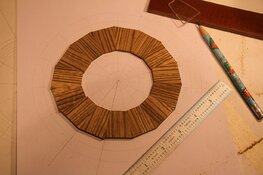While waiting my turn in the spray booth for my first two guitars, thought I'd get a head start on #3. I decided to try a little different rosette. Cut wedges from some zebrawood thins I got from Jason Martin. I'll glue these up and then using my Dremel with the rosette attachment I'll trim it into a nice rosette circle. Then I'll route the next top and glue this zebrawood circle in place with some purfling trim. Once that dries and I sand it flat, I'll route a groove and glue in some abalone down the center of the zebrawood. Hopefully it'll work out as I envision.
Cut all this using a little Japanese saw I got for CHristmas. Made that little plexiglas pattern you see in the photo.

Cut all this using a little Japanese saw I got for CHristmas. Made that little plexiglas pattern you see in the photo.

















